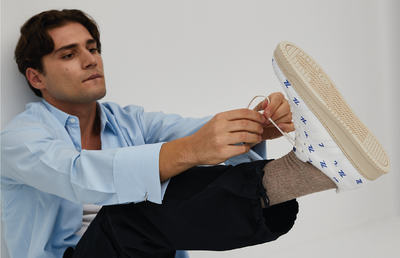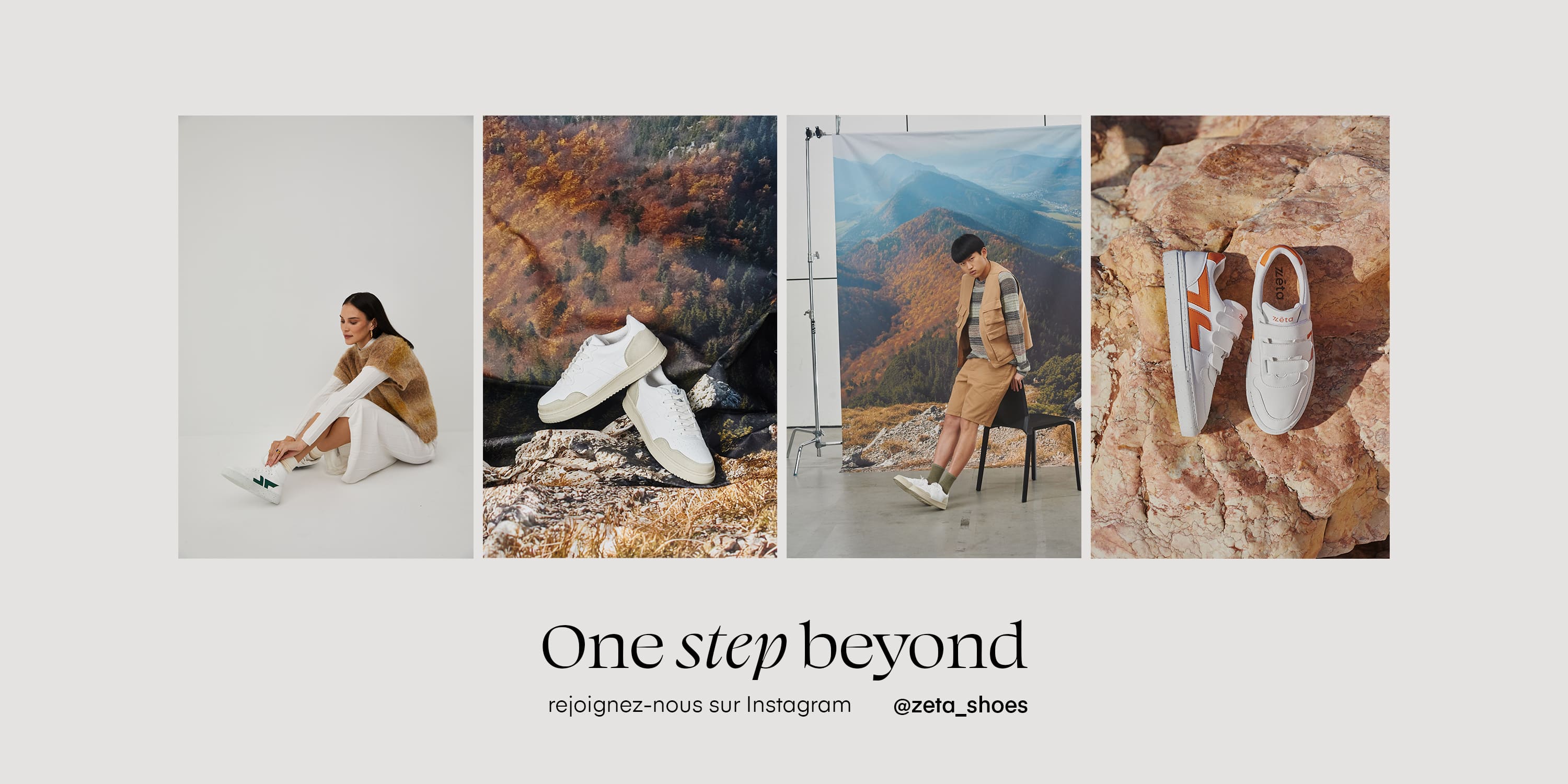In our article from a few months ago, we presented the actions you can take to combat fast fashion. Today, things are moving forward and evolving. We're back to talk about slow fashion, the counter to brands that encourage overconsumption and "disposable clothing."
2. The pillars of Slow Fashion
3. Fashion: a controversial industry
Slow fashion, what is it?
Slow Fashion is a conscious choice to slow down in a fast-paced world, especially in the fashion world. This approach prioritizes sustainability, quality, and integrity at every stage of the creation and consumption of our clothing. In contrast, we find Fast Fashion, which pushes us to buy more and more, faster and faster. Slow Fashion, on the other hand, invites us to pause, think before we buy, and opt for pieces that are carefully crafted, respectful of the environment and the people who make them.
So, we're entitled to wonder why we've been talking so much about fast and slow fashion in recent years. Well, our beautiful blue planet isn't in the best shape, and the fashion industry has a lot to do with it. Between astronomical water consumption, dye pollution, greenhouse gas emissions, transportation, ... our love for fashion comes at a high environmental cost. Not to mention the often precarious conditions of workers in some countries. It's high time we started thinking about fashion that feels good, at all levels.
Every item of clothing we wear has a story: where it comes from, how it was made, who it met, and what journey it took before arriving in our wardrobe? Too often, this story is rather resource-intensive and energy-intensive. Slow Fashion encourages us to write new stories, greener, cleaner, and happier for our planet.
But then, where does the problem come from?
For some time now, we've had the opportunity and access to an astronomical quantity of clothing. The choice is becoming increasingly complicated: with the seasons, trends, fashion, innovations, supplies, prices... the possibilities multiply. So how do you choose? In our opinion, there is no perfect answer to this question; you just have to choose wisely.
- Where do the components come from?
- Where is it made? By whom?
- Are there any labels and other certifications of quality and ethics?
Here are some basic questions to ask yourself, but the main one remains: Do I really need it?
The pillars of Slow Fashion
Slow Fashion begins with conscious production. This means choosing raw materials that respect both the planet and people, minimizing waste and pollution, and ensuring that everyone in the production chain is treated with fairness and respect. It's the promise of a product that has been designed and created with responsible consumption in mind.
The choice of materials is essential. Whether organic cotton, linen, hemp, or even recycled materials, each material is chosen for its low environmental impact. This ensures that your favorite garment isn't contributing to the depletion of our planet's natural resources. This is a good first step toward creating an ethical wardrobe.
In addition, Slow Fashion promotes proximity. Manufacturing locally reduces the carbon footprint associated with transportation and supports the local economy. It also means greater transparency: knowing where, how, and by whom your clothes are made.
Faraway garment factories, where labor is cheap, sometimes hide unsavory realities: poverty wages, long working days, dangerous conditions... By choosing Slow Fashion , we are opting for fashion that respects those who make it, by ensuring good working conditions and a fair wage.
Fashion: A Controversial Industry
As mentioned earlier, fashion trends play a crucial role in our consumption habits and ways. Every year, every season, and even daily, trends evolve. Whether it's colors, cuts, designs, or even materials, fashion creates perishable clothing. Slow Fashion favors timeless garments that won't fall victim to these temporary fads.
Choose pieces that stand the test of time without aging. Classics and basics that can be mixed and matched to suit your personal style. It's the perfect antidote to unbridled consumerism, combining timelessness and quality.
It's better to have fewer, but better-quality clothes. Well-made pieces made with durable materials make all the difference. They last longer, go out of style less quickly, and ultimately, it's a win-win for our wallets and the planet.
There are many brands that have made these values their guiding principle in order to meet a need, rather than create new ones. So when we buy, we should think sustainable rather than modern.
Benefits of Slow Fashion
Adopting Slow Fashion is like choosing a path less traveled, but oh so much more rewarding and enjoyable. Let's take a look at why it's a win-win choice for everyone: the environment, workers, and, of course, us, the consumers.
For our precious environment:
- Reduced carbon footprint: By favoring less energy-intensive production methods and materials, Slow Fashion helps lighten our load on the Earth. Less transport of goods across the globe is already a big step towards a greener future.
- Preservation of natural resources: Choosing renewable, recycled or less water- and energy-intensive raw materials means helping to safeguard our beautiful planet for future generations.
- Reduced pollution: Fewer chemicals in dyeing and fabric processing means fewer toxins released into our ecosystems.
For producers
- Improved working conditions: By supporting brands that treat their employees fairly, we help raise industry standards. Safer workshops, humane working hours, and respect for fundamental rights are the minimum standards for those who make our clothes.
- Fair wages and respect for human rights: Buying clothing from an ethical and responsible brand is a vote for fair pay and respect for the dignity of every worker. It's choosing humanity over profit.
For consumers
- Better quality and more durable clothing: By choosing Slow Fashion, we invest in pieces that stand the test of time and trends. No more disposable clothing, hello to clothes that age gracefully and stylishly.
- Satisfaction of responsible consumption: Knowing that each piece has been carefully chosen, with respect for the environment and people, brings a deep and authentic joy. It is the pride of contributing to a better world, one purchase at a time. In addition, each garment has a story, an experience and evokes anecdotes from its journey.
- Contribution to a fairer and more sustainable industry: Finally, by adopting Slow Fashion, we participate in a global movement for a fairer and more sustainable planet. It means telling ourselves that, together, our choices can shape these industries.
Challenges and prospects
For many, Slow Fashion is nothing more than a utopia. They consider this approach unattainable in the face of giants who wield power over a vast playing field.
But for us, Slow Fashion isn't a utopia; it's a goal. So yes, small gestures may seem insignificant on the scale of the multinationals that govern this industry. But it's by combining these gestures and decisions that things will change.
But let's take a look at the various obstacles and elements that mean that, today, fast fashion is even more developed than slow fashion.
High costs:
The first obstacle is often price. Yes, slow fashion may seem more expensive at first glance. But what factors explain these price differences?
- Materials used: As we've seen, Slow Fashion is all about sturdy materials. For example, a pair of jeans bought for around thirty euros won't have the same properties as those sold for around a hundred euros by French brands. Lined fabric, organic cotton, reinforced seams, etc. So yes, the investment is more significant in the immediate future, but it quickly pays for itself.
- A skilled workforce: by employing craftsmen who are experts in their field, in compliance with ethical standards and working conditions, this is inevitably reflected in costs.
- Research & Development: Slow Fashion stakeholders aim to continuously innovate in order to find ever more innovative and responsible materials. While this comes at a cost, it allows us to offer you innovative, stylish, and sustainable materials.
Perhaps the biggest challenge: changing the way we perceive fashion. This means moving away from instant gratification to a long-term vision, valuing the quality, history, and impact of what we wear.
These are the main challenges facing Slow Fashion today, but there are many others. For example, responsible exports (avoiding cargo ships and other polluting transport) or building credibility for the image, quality, and need for sustainable products.
Exponential development
But rest assured, these challenges in no way limit the ambitions of brands committed to Slow Fashion. Great prospects are also opening up in the world of sustainable and ethical consumption.
Slow Fashion has helped to free up discussion on many issues. Thanks to its initiatives, transparency has become an almost indispensable element in choosing an ethical product.
Whether it's clarity on origin, manufacturing conditions, or the impact of products at each stage of the production process, these elements are still too often lacking. To move forward, we must push the industry towards greater transparency. This will allow us, as consumers, to make informed choices and support good practices.
It is crucial to continue putting pressure on brands to adopt more ethical practices. This includes supporting initiatives that promote social and environmental responsibility in the fashion industry, as well as implementing restrictive legislation.
Ultimately, it is together that we will succeed in making things happen. It is up to each of us, at our own level, to educate people about good consumer habits so that in 20 years, we will still be able to dress stylishly, but ethically.
Faced with these challenges, the road to truly sustainable fashion may seem long. But every step counts. Through education, innovation, and collective commitment, we can transform these challenges into opportunities to build a future of fashion that is as brilliant as it is responsible. Together, let's shape the vision of a fashion that celebrates beauty and style, without compromising our planet or our humanity.
Slow Fashion, for a sustainable future
Slow Fashion isn't just a passing trend; it's a movement that invites us to rethink our relationship with fashion. It's a call to reflection, action, and lasting change in the way we produce, consume, and think about our clothes. By choosing Slow Fashion, we're opting for a fashion that respects the planet, values human labor, and promotes more conscious and thoughtful consumption.
- Adopting the principles of Slow Fashion: It starts with simple actions: prioritizing quality over quantity, opting for sustainable materials, and thinking before you buy. Every choice counts and can make a significant difference.
- Support ethical and local brands: By choosing where to spend our money, we have the power to encourage ethical practices and support the local economy. Let's seek out and promote brands that are committed to fairer and more sustainable fashion.
- Making Slow Fashion a universal movement: The power of change lies in unity. By sharing our knowledge, talking with our loved ones, and promoting the principles of Slow Fashion on social media and in our community, we can help expand its influence.
The transition to more responsible fashion is not a solitary quest, but a collective adventure. It is up to all of us to lay the foundations for a future where fashion is synonymous with sustainability, ethics, and respect.
Slow Fashion offers us the opportunity to reinvent our wardrobes and our impact on the world. This is the moment to make fashion a force for good—for ourselves, for our communities, and for our planet. Together, let's make Slow Fashion not the exception, but the norm.
Opting for Slow Fashion is a bit like choosing a path less traveled, but so much more rewarding. It's promising to wear clothes that have meaning, that last a long time, and that tell a beautiful story. It's saying yes to ethical, responsible fashion, and quite simply better for us and for the planet.




























































